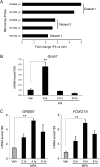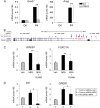Growth regulation by estrogen in breast cancer 1 (GREB1) is a novel progesterone-responsive gene required for human endometrial stromal decidualization
- PMID: 28911214
- PMCID: PMC5909854
- DOI: 10.1093/molehr/gax045
Growth regulation by estrogen in breast cancer 1 (GREB1) is a novel progesterone-responsive gene required for human endometrial stromal decidualization
Abstract
Study question: Is Growth Regulation by Estrogen in Breast Cancer 1 (GREB1) required for progesterone-driven endometrial stromal cell decidualization?
Summary answer: GREB1 is a novel progesterone-responsive gene required for progesterone-driven human endometrial stromal cell (HESC) decidualization.
What is known already: Successful establishment of pregnancy requires HESCs to transform from fibroblastic to epithelioid cells in a process called decidualization. This process depends on the hormone progesterone, but the molecular mechanisms by which it occurs have not been determined.
Study design, size, duration: Primary and transformed HESCs in which GREB1 expression was knocked down were decidualized in culture for up to 6 days. Wild-type and progesterone receptor (PR) knockout mice were treated with progesterone, and their uteri were assessed for levels of GREB1 expression.
Participants/materials, setting, methods: Analysis of previous data included data mining of expression profile data sets and in silico transcription factor-binding analysis. Endometrial biopsies obtained from healthy women of reproductive age during the proliferative phase (Days 8-12) of their menstrual cycle were used for isolating HESCs. Experiments were carried out with early passage (no more than four passages) HESCs isolated from at least three subjects. Transcript levels of decidualization markers prolactin (PRL) and insulin-like growth factor-binding protein-1 (IGFBP-1) were detected by quantitative RT-PCR as readouts for HESC decidualization. Cells were also imaged by phase-contrast microscopy. To assess the requirement for GREB1, PR and SRC-2, cells were transfected with specifically targeted small interfering RNAs. Results are shown as mean and SE from three replicates of one representative patient-derived primary endometrial cell line. Experiments were also conducted with transformed HESCs.
Main results and the role of chance: Progesterone treatment of mice and transformed HESCs led to an ~5-fold (5.6 ± 0.81, P < 0.05, and 5.2 ± 0.26, P < 0.01, respectively) increase in GREB1 transcript levels. This increase was significantly reduced in the uteri of PR knock-out mice (P < 0.01), in HESCs treated with the PR antagonist RU486 (P < 0.01), or in HESCs in which PR expression was knocked down (P < 0.05). When GREB1 expression was knocked down, progesterone-driven decidualization markers in both immortalized and primary HESCs was significantly reduced (P < 0.05 and P < 0.01). Finally, GREB1 knock down signficantly reduced expression of the PR target genes WNT4 and FOXOA1 (P < 0.05 and P < 0.01, respectively).
Large scale data: This study used the Nuclear Receptor Signaling Atlas.
Limitations, reasons for caution: Although in vitro cell culture studies indicate that GREB1 is required for endoemtrial decidualization, the in vivo role of GREB1 in endometrial function and dysfunction should be assessed by using knock-out mouse models.
Wider implications of the findings: Identification and functional analysis of GREB1 as a key molecular mediator of decidualization may lead to improved diagnosis and clinical management of women with peri-implantation loss due to inadequate endometrial decidualization.
Study funding and competing interest(s): This research was funded in part by: a National Institutes of Health (NIH)/ National Institute of Child Health and Human Development (NICHD) grant (R00 HD080742) and Washington University School of Medicine start-up funds to R.K., an NIH/NICHD grant (RO1 HD-07857) to B.W.O.M., and a NIH/NICHD grant (R01 HD-042311) to J.P.L. The authors declare no conflicts of interests.
Keywords: decidualization; differentiation; endometrium; gene transcription; progesterone.
© The Author 2017. Published by Oxford University Press on behalf of the European Society of Human Reproduction and Embryology. All rights reserved. For Permissions, please email: journals.permissions@oup.com
Figures






References
-
- Bentel JM, Birrell SN, Pickering MA, Holds DJ, Horsfall DJ, Tilley WD. Androgen receptor agonist activity of the synthetic progestin, medroxyprogesterone acetate, in human breast cancer cells. Mol Cell Endocrinol 1999;154:11–20. - PubMed
-
- Brosens JJ, Hayashi N, White JO. Progesterone receptor regulates decidual prolactin expression in differentiating human endometrial stromal cells. Endocrinology 1999;140:4809–4820. - PubMed
-
- Carson DD, Bagchi I, Dey SK, Enders AC, Fazleabas AT, Lessey BA, Yoshinaga K. Embryo implantation. Dev Biol 2000;223:217–237. - PubMed
Publication types
MeSH terms
Substances
Grants and funding
LinkOut - more resources
Full Text Sources
Other Literature Sources
Molecular Biology Databases
Research Materials
Miscellaneous

